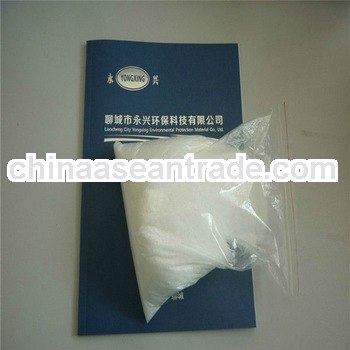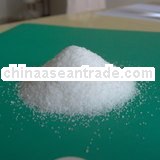Brand:aa
Product detail:
Cationic Polyacrylamide
Features
- PAM molecular chains fix on different surfaces of particles bettween that polymer bridges were formed, which makes aggregates of particles form and settle .
- it has function of surface adsorption the porlar groups of PAM molecule have adsorption for particles with opposite polar charges
- PAM molecular chains will link the dispersed particles and form it to network –lile so as to enhance its treatment funtion.
Application
- used to industries wastewater treatment of electroplating . circuit board. Paper making . printing&dyeing. Bleaching&dyeing and tanning etc.
- used for urban life sewage purification
- used for tap water purification etc.
- used for drying of sludge dewatering
Quality specification
Executive standard ISO9001
Item | index |
Appearance | White or light yellow granule or pulvis |
Molecular weight,deviation with standard < 10% | 8million – 12 million |
Ion degrees | 20% --60% |
Hydrolysis degree, deviation with standard<2% | 25% --35% |
Solid content % >= | 90 |
Acrylamide monomer content(dry basis %)<= | 0.2 |
Dissolve time,min<= | 90 |
PH value(1% water solutiom) | 6.9 |
How to use
Dispensing it at the time of using gennerally, avoid to stirring it speedily. Dose after diluting it to solution with 0.1% density
Packing, storage and transportation
Packed with 25 kgs woven bag or paper bag
Stored in a dry , cool and ventilate place , it will keep good for 6 mouths.
Uses of polyacrylamide
One of the largest uses for polyacrylamide is to flocculate solids in a liquid. This process applies to wastewater treatment, and processes like paper making. Most polyacrylamide is supplied in a liquid form. The liquid is subcategorized as solution and emulsion polymer. Even though these products are often called 'polyacrylamide', many are actually copolymers of acrylamide and one or more other chemical species, such as an acrylic acid or a salt thereof. The main consequence of this is to give the 'modified' polymer a particular ionic character.
Another common use of polyacrylamide and its derivatives is in subsurface applications such as Enhanced Oil Recovery. High viscosity aqueous solutions can be generated with low concentrations of polyacrylamide polymers, and these can be injected to improve the economics of conventional waterflooding.
It has also been advertised as a soil conditioner called Krilium by Monsanto Company in the 1950s and today "MP", which is stated to be a "unique formulation of PAM (water-soluble polyacrylamide)". It is often used for horticultural and agricultural use under trade names such as Broadleaf P4, Swell-Gel and so on. The anionic form of cross-linked polyacrylamide is frequently used as a soil conditioner on farm land and construction sites for erosion control, in order to protect the water quality of nearby rivers and streams.[2]
The polymer is also used to make Gro-Beast toys, which expand when placed in water, such as the Test Tube Aliens. Similarly, the absorbent properties of one of its copolymers can be utilized as an additive in body-powder.
The ionic form of polyacrylamide has found an important role in the potable water treatment industry. Trivalent metal salts like ferric chloride and aluminium chloride are bridged by the long polymer chains of polyacrylamide. This results in significant enhancement of the flocculation rate. This allows water treatment plants to greatly improve the removal of total organic content (TOC) from raw water.
Polyacrylamide is often used in molecular biology applications as a medium for electrophoresis of proteins and nucleic acids in a technique known as PAGE.

















 Legal status confirmed
Legal status confirmed








